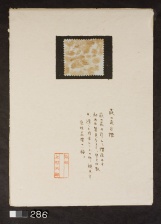Difference between revisions of "Hagi (Lespedeza bicolor) - center (286 C)"
Jump to navigation
Jump to search
(username removed) |
(username removed) |
||
| Line 5: | Line 5: | ||
| 286 | | 286 | ||
|- | |- | ||
| − | ! scope="row"| | + | ! scope="row"|Uemura number / title |
| − | | | + | | ; "Haze-some 25" |
|- | |- | ||
! scope="row"|Folder location | ! scope="row"|Folder location | ||
| Line 41: | Line 41: | ||
| - | | - | ||
|- | |- | ||
| − | ! scope="row"| | + | ! scope="row"|Uemura's notes |
| The dyed color would discolor within a couple of days to a month. This is one of the primitive dyeing techniques using fresh flower petals. | | The dyed color would discolor within a couple of days to a month. This is one of the primitive dyeing techniques using fresh flower petals. | ||
|- | |- | ||
| − | ! scope="row"| | + | ! scope="row"|Uemura's date |
| Kyoto | | Kyoto | ||
|} | |} | ||
| − | [[Category: | + | [[Category:Uemura dye archive]] |
Revision as of 07:20, 24 July 2013
| Museum number | 286 |
|---|---|
| Uemura number / title | ; "Haze-some 25" |
| Folder location | 4th shelf |
| Sample location | center (286 C) |
| Fiber type | silk |
| Color | brown stains |
| Dyestuff (Japanese common name) | 萩 : Hagi |
| Dyestuff (botanical name) | Lespedeza bicolor Turcz. (L. bicolor var. japonica Nakai) |
| Plant part | flower petal /fresh |
| Dyestuff extraction | rubbed onto the fabric |
| Auxiliary agent in dye bath | - |
| Mordant | - |
| Other auxiliary agent | - |
| Uemura's notes | The dyed color would discolor within a couple of days to a month. This is one of the primitive dyeing techniques using fresh flower petals. |
| Uemura's date | Kyoto |
